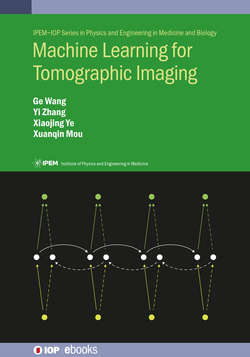Читать книгу Machine Learning for Tomographic Imaging - Professor Ge Wang - Страница 29
На сайте Литреса книга снята с продажи.
2.2.1 Matching pursuit algorithm
ОглавлениеFor the purpose of finding a least set of atoms and determining the corresponding coefficients to represent a signal, the essence of the MP algorithm aims to find the atom with the highest correlation with the signal and removes the component of this atom from the signal. This process is repeated iteratively until the stop condition is met. More specifically, let us take a closer look at the steps to use MP for signal representation. k represents the index of iteration number, yk=Dαk is the current approximation, the signal is denoted as y, and the current residual is Rky:
Initialization: R0y=yy0=0k=1
Step 1. Calculate the inner product of the signal y with each column (atoms) in the dictionary D, denoted as ⟨R0y,dk⟩k.
Step 2. Find an atom in the dictionary which yields the maximum inner product satisfying ⟨R0y,dr0⟩⩾supj∈(1,…,K)⟨R0y,dj⟩, where r0 is the column index of the corresponding atom in D.
Hence, in the first iteration, an intermediate representation of the single y0 consists of two parts, as follows:
y0=⟨R0y,dr0⟩dr0+R1y.(2.6)
In this equation, the first part is the orthogonal projection of the most matching atom dr0 on the span of ⟨R0y,dr0⟩, and the second part is the residue.
Step 3. Increment k, repeat steps 1 and 2 for the kth residue Rky.
So, in the kth iteration, the signal is represented as follows:
Rky=〈Rky,drk+1〉drk+1+Rk+1y.(2.7)
Step 4. Stop the iterations until the residue satisfies the given convergence criterion. The signal is finally approximated as y≈∑n=0k⟨Rny,drn⟩drn.
Let us take a very simple example to explain the searching process for the MP algorithm. Suppose that the observed data are y=(−1,−2)T and a dictionary D=1.3−100.30.8−1, each column of which is one atom. We also set the coding errors Er=0.8. Figure 2.2 shows the intuitive process of the MP algorithm to find optimal α to represent y, which contains four steps. Under such a coding error vector, the observed data y are finally represented as y≈−1.3·d2+2·d3 by using two of three atoms in the dictionary.
Figure 2.2. An example to illustrate the searching process of the MP algorithm when observed signal y and a dictionary D are given, rk denotes the residue of the kth iteration.
One of the problems with MP is that it may pick up the same atom multiple times. Orthogonal matching pursuit (OMP) (Pati et al 1993) corrects this issue by updating all the nonzero coefficients according to a least-squares criterion in each step, which makes the residual orthogonal to the chosen atoms. It means that each atom would not be picked more than once and hence this strategy results in a faster convergence.
So, at the kth iteration, the OMP gives the signal representation as follows:
y=∑n=1kαnkdn+Rky,with⟨Rky,dn⟩=0,n=1,…,k.(2.8)
Still, OMP is a greedy approach that iteratively finds the locally optimal choice in hope of approximating the global minimum. This is a reasonable compromise for the sparse approximation problem, given that the global solution for the NP-hard problem is practically unreachable. Instead, sequentially refining the entries in α to reduce the approximation error is very computationally efficient. Various extensions were proposed to accelerate the convergence of OMP (such as compressive sampling OMP (CoSaMP) (Needell and Tropp 2009), regularized OMP (ROMP) (Needell and Vershynin 2010), and stagewise OMP (StOMP) (Donoho et al 2012)).
Currently, sparse approximation algorithms are widely used in image processing, audio processing, machine learning, and many other fields. An unknown signal is usually modeled as a sparse combination of a few atoms in a given dictionary. The use of sparsity-inspired models often yields state-of-the-art results in a variety of applications.
